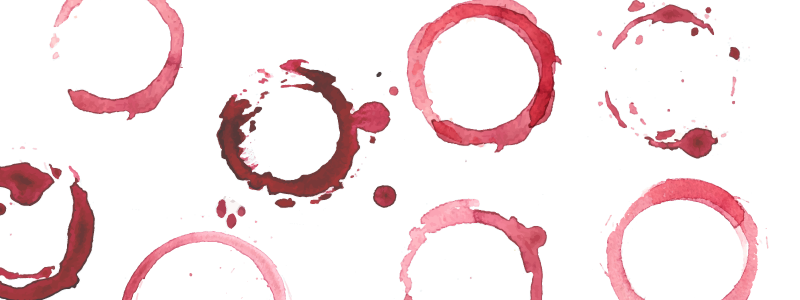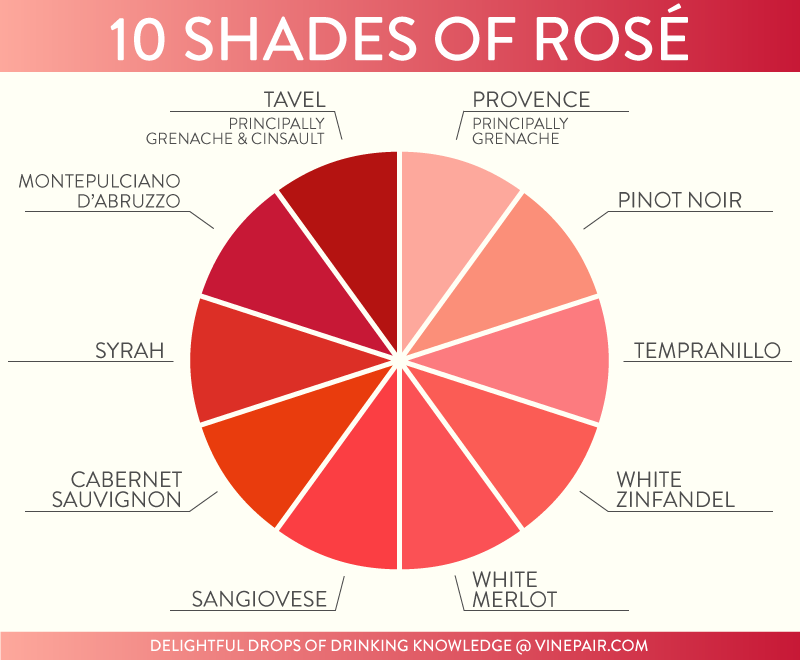America loves rosé. Exports of the pretty pink wine from Provence to the U.S. spiked 29% in volume from October 2013 to October 2014 – and that’s just one small slice of the rosé pie. These days, it seems every winery is vying to make their own popular rosé. Rosé is often known as “pink wine,” but just how pink is pink? If you’re only drinking pale rosés, you’re limiting yourself to one side of the rosé taste spectrum. Rosé can range from peach colored to nearly red, and you should be drinking it in every color. Here’s how different shades of rosé taste from lightest to darkest.
Provence rosés are primarily made from Grenache grapes, which are often blended with Syrah and Cabernet Sauvignon. They’ll typically have bright flavors like sweet berries, watermelon, grapefruit, and freshly chopped herbs. Provence produces the most dry rosé in the world and is a wine store staple.
Pinot Noir rosé is a shade darker than Provence rosé, but shares a lot of the same fruit notes, such as strawberries and melon. It’s also similarly bright and acidic. However, Pinot Noir rosé is a bit earthier than rosé from Provence. It also lacks that “flower” taste found in the dainty Provence rosés.
Tempranillo rosés are a little spicier than Provence rosés or Pinot Noir rosés, but still have those same refreshing berry tastes. Much like Rioja (which is made from Tempranillo grapes), Tempranillo rosé will have that telltale green pepper flavor. Tempranillo rosé also shares the same floral quality found in rosé from Provence.
White Zinfandel is sweet, bright pink rosé that’s developed a little bit of a reputation as being sweet and basic due to its low price point and accidental invention. However, tropical flavors such as pineapple and banana make a great accompaniment to buttery pasta, or provide a nice foil to crisp vegetable-based dishes and anything that involves a tart, sharp pickled flavor.
White Merlot is quite similar to White Zinfandel in production and taste. It’s sweet and tastes like a raspberry tart or another decadent berry-forward dessert, like jam crepes. Like White Zinfandel, you can use it with similarly rich foods or pair it with sour foods to contrast the sweetness with stark, acidic flavors.
Sangiovese rosé has pink undertones as opposed to hues of orange. This vibrant wine strikes a delightful balance between dryness and fruit-forward flavor. You’ll get a mouth full of cranberries, raspberries, and honeydew.
Cabernet Sauvignon grapes are used in rosé from all over the world. A bit darker than rosé made from Sangiovese and Tempranillo grapes, Cab Sauvignon rosé boasts hints of sweet, tangy citrus in addition to savory flavors such as leather, tobacco, and pepper. For all of those robust flavors, this rosé is crisp and acidic. You can even pair Cabernet Sauvignon rosé with light seafood or a diced veggie platter.
Syrah rosé is dark red – a clear indicator of the grapes from which it’s made. Syrah is a very tannic grape, so it produces a more hearty rosé. However, in addition to strength, Syrah rosé is full of mouthwatering purple fruit. Expect plums, dried cherries, and fresh blueberries mingling with hints of smoke and spice. This is great with stews that have both savory and sweet elements, like meat and ripe tomato.
Montepulciano rosé is a deep ruby color. In fact, it’s labeled “cerasuolo,” which means cherry red. This wine is medium bodied, with sophisticated spices and fruit you might add to mulled wine. Think cloves, cinnamon, orange peel, and dried fruit. Montepulciano rosé is made in Italy’s Abruzzo region, where the pigment-rich Montepulciano grape skins easily color the juice in a short amount of time.
Tavel is a region of the Rhône Valley dedicated to exclusively making rosé. Comprised mainly of Grenache grapes, this is the rosé for red wine lovers. Tavel rosé is hearty, spicy, and full of assertive tannins. It’s a pink wine that can actually stand up to meats and other strong flavors and textures. Tavel rosé is very dark, its intense color indicative of the powerful taste in the bottle.


